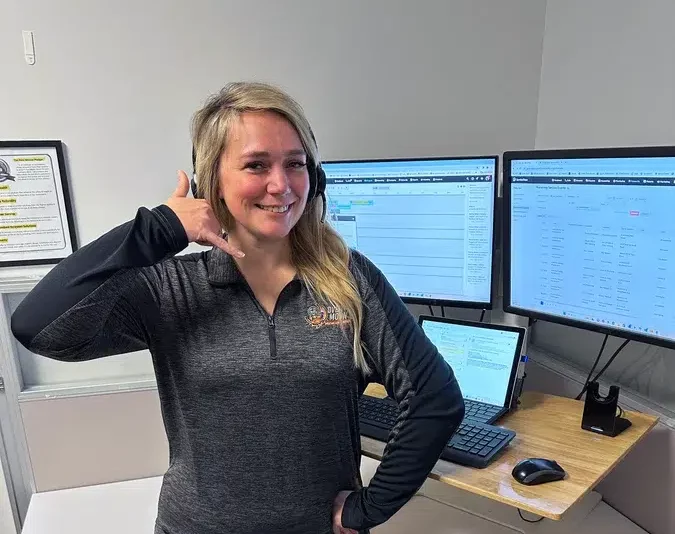Indoor Air Quality Services in Brookfield, WI
Serving Greater Milwaukee
Over the Moon: Professional Indoor Air Quality Testing and Improvement

Indoor Air Quality Services Brookfield, WI
We all face and accept a variety of risks in our daily lives. But not everyone is aware of poor indoor air quality (IAQ) at home. But the hard truth is—particulates, household chemicals, and organic pathogens can concentrate in our homes and create serious health risks. At Over the Moon, we provide air quality services to determine what’s polluting your home’s air and find solutions to improve the situation.
Poor indoor air quality can make you sick. The symptoms of polluted air in your home range from sneezing and coughing to asthma to more serious health issues. Long-term exposure to some pollutants, such as smoke or radon, can increase the risk of lung cancer. Soot, ozone, carbon monoxide, and other contaminants can put you at risk of a heart attack or stroke. At the very least, poor IAQ can cause discomfort and make it difficult to sleep.
Schedule ServiceOur HVAC Services
Types of Indoor Air Quality Testing We Provide
When evaluating your home, we’ll use the appropriate test methods to check for:
Carbon Monoxide
It’s odorless and colorless, but carbon monoxide can be present in any home. This by-product of combustion can be released by a malfunctioning furnace or gas appliance. In light concentrations, it can cause fatigue and flu-like symptoms. High concentrations of CO are often deadly. We use the latest equipment to detect the smallest amounts and determine their source.
Humidity
Most people don’t consider humidity a hazard. Nonetheless, it can increase the concentration of some pollutants. Water molecules can hold onto some allergens and support bacterial growth. High humidity can also increase the risk of viral infections and attract dust mites that cause allergy symptoms
Particles
Particulate matter (PM) is a common indoor pollutant. Particles vary in size and many are microscopic. The smaller the particle, the deeper into the lungs it can reach and the greater the potential for long-term damage.
Sources of PM include cooking, heating, cleaning, and consumer products such as printers and copiers. Fireplaces, candles, space heaters, and other heating equipment can also introduce PM into your home. Biological sources include pets and other animals, vermin, insects, plants, and mold. And PM can originate from outdoors as well, from sources such as pollen, vehicle exhaust, and wildfires.
Odors
Unpleasant odors can affect your quality of life and well-being. They can also signal certain chemicals may be in the air, even in low concentrations. If an odor is stronger in a certain area and associated with other physical symptoms, it can be considered an IAQ issue. You should call a professional to investigate it.
Mold
Mold can quickly spread through the air and into your air ducts. It can trigger allergic reactions. Some molds release mycotoxins that can cause severe illness if inhaled. The presence of mold is often associated with high humidity, dampness, a leak, or a flood. If you can’t clean the mold, call a professional to test what type it is and provide mold remediation and moisture control solutions.
Services We Offer
Over the Moon provides a range of effective solutions to improve indoor air quality, including:
- UV Lights: Installing an ultraviolet light in your HVAC system can kill bacteria, mold, and other organic contaminants by damaging their genetic material. Therefore, UV light can neutralize and eliminate harmful organisms.
- Humidifiers: Dry air can aggravate allergies and make it easier to catch a cold or the flu. It can also increase static electricity. A humidifier adds moisture to the air. In the right amounts, it can improve comfort and indoor air quality.
- Dehumidifiers: Depending on the humidity level in your home, a dehumidifier can improve IAQ. It is not an air purifier in and of itself, but a dehumidifier can reduce mold and mildew, dust mites, and some volatile organic compounds.
Over the Moon Service
You won’t pay until you’re 100% satisfied with the service we’re providing you. We’re committed to ensuring you receive the best.
White Glove Treatment
We go out of our way to respect your home. Floor protectors, shoe covers, gloves, deodorizer spray—we bring it all. When we leave, the space will be cleaner than when we arrived.
Screened & Certified
Never worry about who’s entering your home. Our technicians are screened, drug tested, and professionally trained.
Signs of Poor Indoor Air Quality
Call an IAQ professional if you often experience symptoms such as:
- Itchy Eyes
- Runny Nose
- Coughing
- Sneezing
- Dizziness
- Dry, Irritated Skin
- Headache
- Fatigue
- Difficulty Breathing
- Frequent Colds
- Asthma Attacks
Contact Over The Moon
Indoor pollution may be affecting your comfort and health and you don’t even know it. Our licensed professionals address the indoor air quality needs of clients in and around Brookfield, WI. To schedule indoor air quality testing and receive recommendations on IAQ solutions, contact us online or call us today.
Schedule Service

